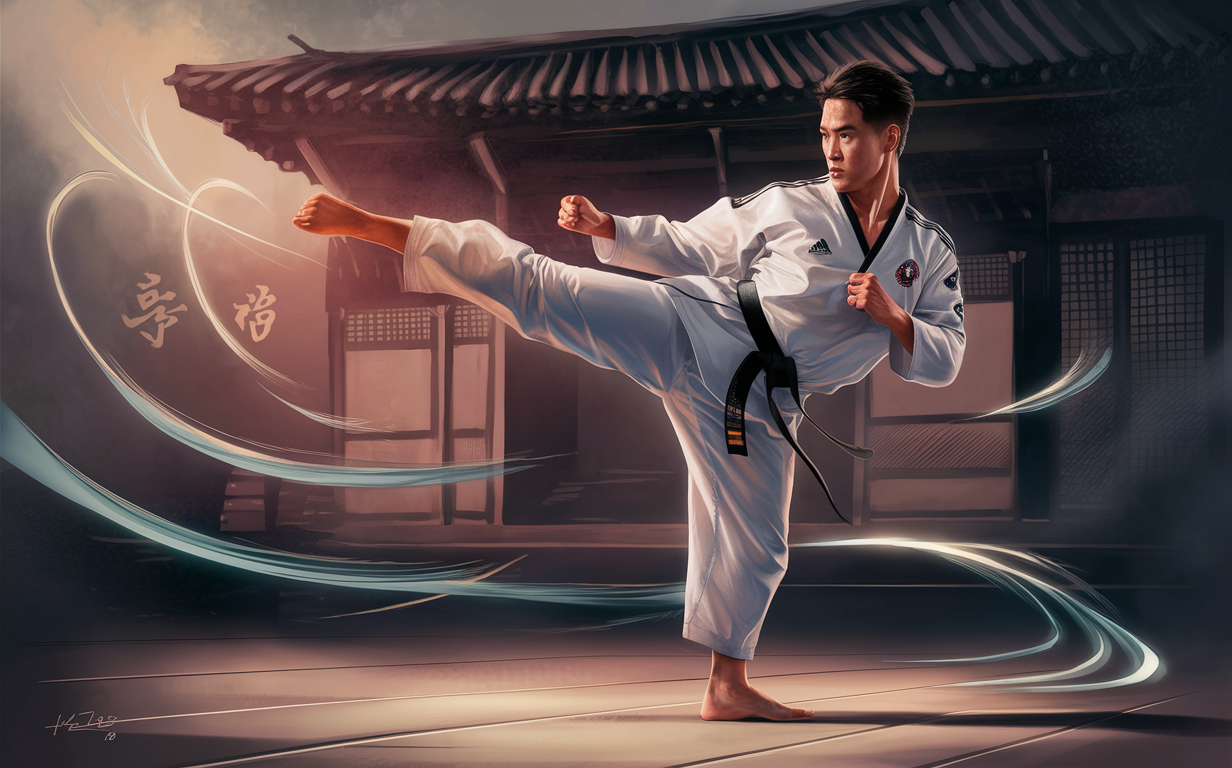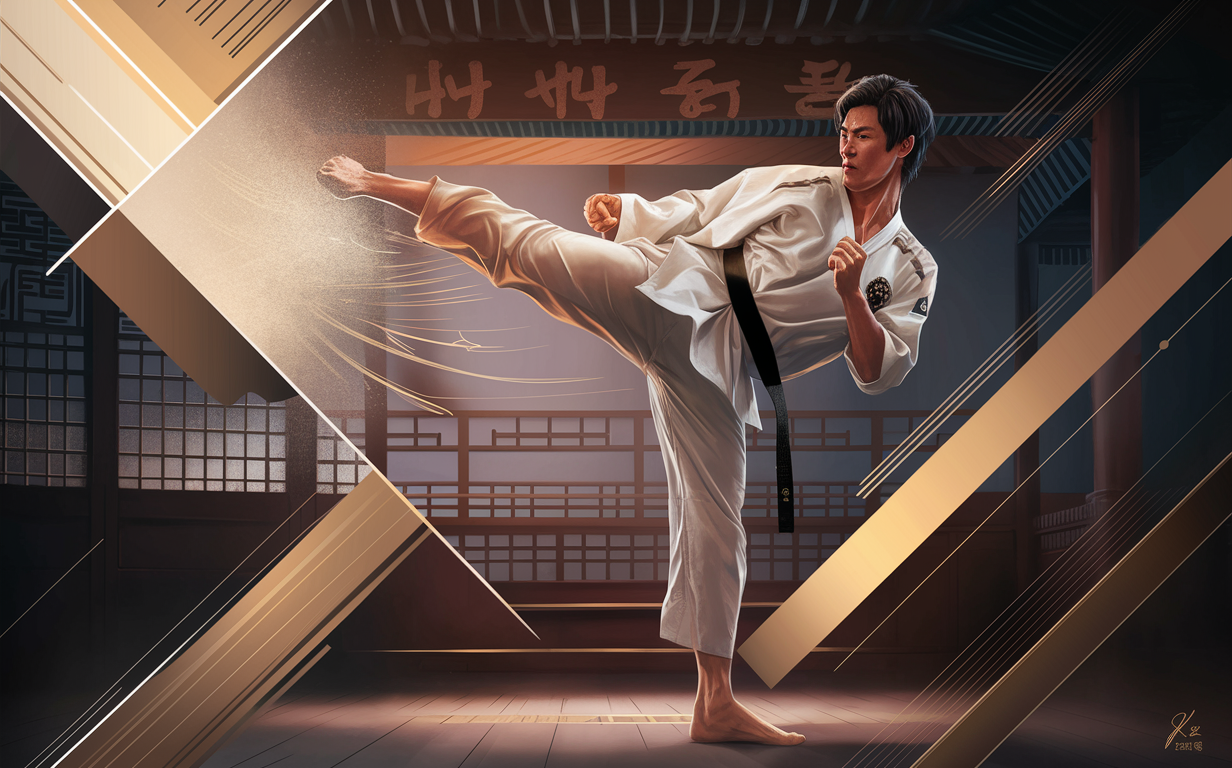Taekwondo is a dynamic martial art known for its powerful kicks, intricate forms, and effective self-defense techniques. Whether you’re a beginner seeking to improve your skills or an advanced practitioner aiming to perfect your techniques, understanding the fundamentals and advanced aspects of Taekwondo techniques and forms is crucial.
Key Takeaways
- Taekwondo is a Korean martial art focused on high, fast kicks and jumping spinning kicks.
- Techniques range from basic stances and strikes to complex spinning kicks and joint locks.
- Forms (Poomsae) are pre-arranged sequences of movements that simulate combat scenarios.
- Improving focus, discipline, and physical fitness are core benefits of practicing Taekwondo.
to Taekwondo Techniques
Taekwondo techniques are a blend of hand strikes, kicks, blocks, stances, and more. Each move is designed for both offense and defense, making it a versatile martial art. Let’s dive into the fundamental techniques that every practitioner should master.
Basic Stances
Stances form the foundation of all techniques. They ensure stability and readiness for both attack and defense.
Ready Stance (Joonbi)
This stance is your starting position, feet shoulder-width apart, knees slightly bent, and hands in front of your body. It’s crucial for maintaining balance and preparing for movement.
Front Stance (Ap Kubi)
In this stance, one foot is placed forward, and the other is back with the legs apart. The front knee is bent, and the back leg is straight. This stance is essential for powerful forward movements.
Back Stance (Dwit Kubi)
Here, the back foot is turned sideways, and the front foot points forward. The majority of your weight is on the back leg. This stance is used for defensive maneuvers.
Essential Hand Techniques

Hand techniques in Taekwondo include various strikes and blocks. These techniques are pivotal for both offense and defense.
Basic Strikes
A fundamental strike, the punch involves extending the arm straight from the ready position to target the opponent’s vital points.
Knife-Hand Strike (Sonkal Taerigi)
This strike uses the edge of the hand to deliver a powerful blow. It’s effective for targeting the neck or collarbone.
Basic Blocks
Low Block (Arae Makgi)
This block deflects low attacks such as kicks. It’s executed by swinging the arm downward from the shoulder.
High Block (Eolgul Makgi)
This block protects the head and upper body from high attacks. The arm is raised above the head to intercept incoming strikes.
Dynamic Kicks in Taekwondo
Kicks are the hallmark of Taekwondo, known for their speed and power. Here are some of the most important kicks to master.
Front Kick (Ap Chagi)
This kick involves lifting the knee and snapping the foot forward to strike the opponent’s midsection. It’s quick and effective.
Roundhouse Kick (Dollyo Chagi)
The roundhouse kick is delivered by pivoting on the supporting foot and swinging the attacking leg in a circular motion. It’s a powerful kick targeting the sides of the opponent.
Side Kick (Yop Chagi)
This kick is executed by extending the leg sideways, using the heel to strike the target. It is highly effective for keeping the opponent at a distance.
Spinning Hook Kick (Dwi Huryo Chagi)
A more advanced kick, the spinning hook kick involves a full-body turn to deliver a powerful heel strike. It requires excellent balance and timing.
Understanding Taekwondo Forms (Poomsae)

Forms, known as Poomsae, are sequences of movements that simulate combat scenarios. They are essential for developing technique, balance, and discipline.
Importance of Forms
Practicing forms helps improve muscle memory, precision, and fluidity in movements. It also provides a deeper understanding of the application of techniques.
Basic Forms
Taegeuk Il Jang
The first form of Taekwondo, Taegeuk Il Jang, focuses on fundamental stances and strikes. It’s suitable for beginners to build their basic skills.
Taegeuk Ee Jang
The second form introduces more complex techniques, including different types of blocks and strikes. It emphasizes fluid transitions between movements.
Advancing to Complex Forms
As practitioners progress, they learn more advanced forms that incorporate intricate techniques and combinations.
Koryo
Koryo is an advanced form that includes techniques for both offense and defense. It demands precision, power, and control.
Keumgang
Keumgang focuses on strength and stability. It includes powerful stances and strikes, symbolizing the unyielding and majestic nature of a diamond.
According to a study by IBISWorld, the market size for “ask” services in the United States was estimated at $2.8 billion in 2022, with an annual growth rate of 2.3% from 2017 to 2022.
- The average cost of a professional “ask” service can range from $25 to $100 per hour, depending on the complexity of the task and the expertise required.
- According to PayScale, the median hourly rate for “ask” skills in the United States is around $18.50.
- A report by Grand View Research estimates that the global “ask” services market will reach $8.7 billion by 2028, growing at a CAGR of 6.2% from 2021 to 2028.
It’s important to note that these costs and statistics can vary depending on the specific type of “ask” service, location, and other factors. It’s always recommended to research and compare different options to find the most suitable and cost-effective solution for your needs.
First-Hand Experience: Real-Life Benefits

Practicing Taekwondo offers numerous real-life benefits beyond self-defense. Here are some experiences shared by our students at Thrive7 Martial Arts:
- Improved Confidence: Many students have reported increased self-confidence, both in and out of martial arts training.
- Enhanced Focus: Regular practice has helped students improve their concentration and focus, positively impacting their academic and professional lives.
- Better Physical Fitness: Taekwondo provides a full-body workout, helping students stay fit and healthy.
Comparison of Basic and Advanced Kicks
| Kick Type | Complexity Level | Primary Target Area | Key Benefit |
|---|---|---|---|
| Front Kick (Ap Chagi) | Basic | Midsection | Quick and effective |
| Roundhouse Kick (Dollyo Chagi) | Basic | Sides | Powerful |
| Side Kick (Yop Chagi) | Intermediate | Midsection, Distance | Effective distancing |
| Spinning Hook Kick (Dwi Huryo Chagi) | Advanced | Head, Midsection | High power, requires balance |
Integrating Techniques into Practice
To effectively integrate these techniques into your practice, consider the following tips:
- Consistency: Regular practice is key to mastering techniques and forms.
- Focus on Form: Pay attention to the details of each movement to ensure proper execution.
- Seek Feedback: Work with instructors and peers to get constructive feedback and improve your techniques.
Tips for Practicing Taekwondo Forms
- Break down forms into smaller sequences to understand each movement.
- Practice in front of a mirror to check your posture and alignment.
- Visualize real combat scenarios while performing forms.
- Record your practice sessions to review and identify areas for improvement.
- Stay relaxed and focused to maintain fluidity in movements.
Conclusion
Taekwondo techniques and forms are fundamental to the practice of this martial art. By mastering basic and advanced techniques, practitioners can improve their physical fitness, mental discipline, and self-defense skills. At Thrive7 Martial Arts, we offer comprehensive training programs to help you achieve your Taekwondo goals. Join us today and experience the transformative power of martial arts.
Join Thrive7 Martial Arts
Ready to take your Taekwondo skills to the next level? Join our classes at Thrive7 Martial Arts and benefit from personalized training, experienced instructors, and a supportive community. Contact us today to get started!
Phone: 714-237-9988 Email: info@thrive7martialarts.com Address: 1876 N Placentia Ave, Placentia, CA 92870
FOLLOW US: – Facebook – Twitter – Instagram
Thrive7 Martial Arts | Placentia, CA | © 2023

